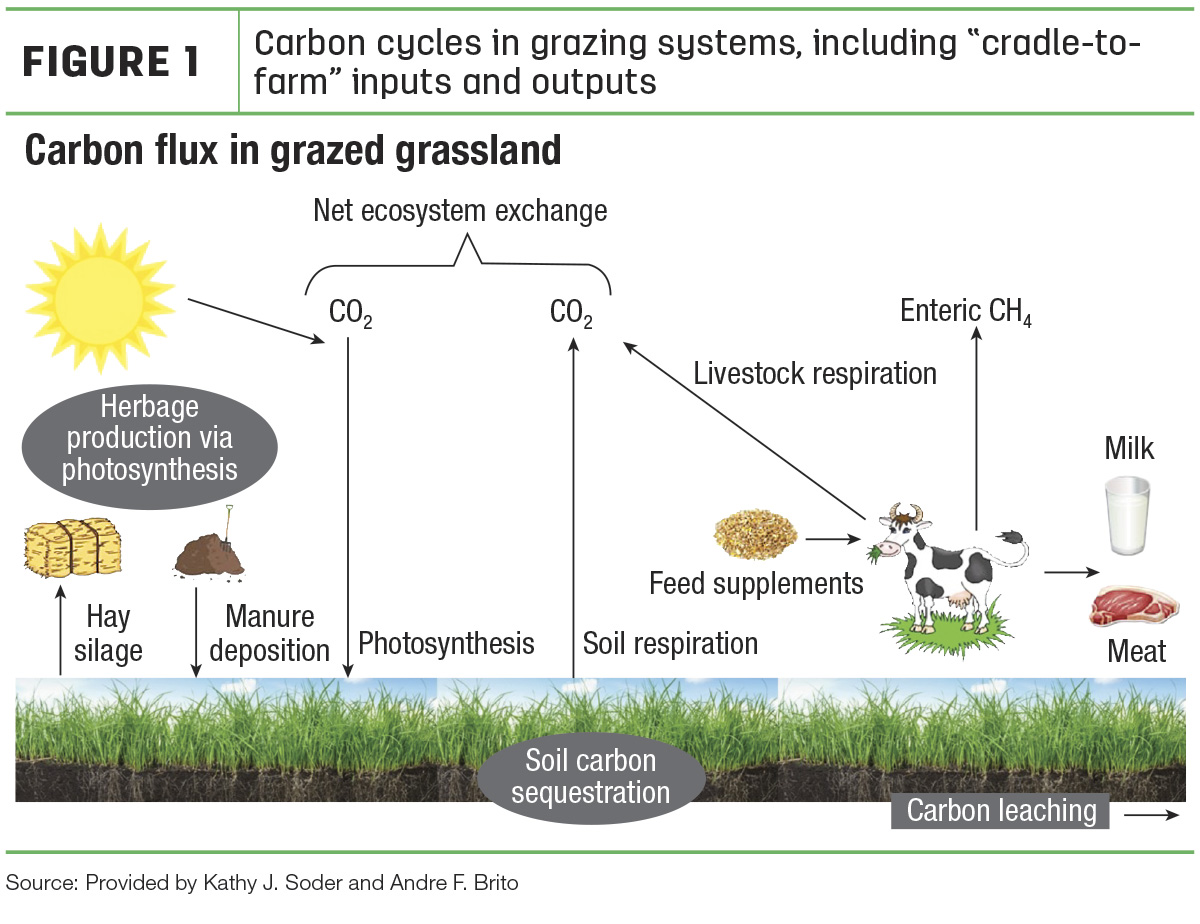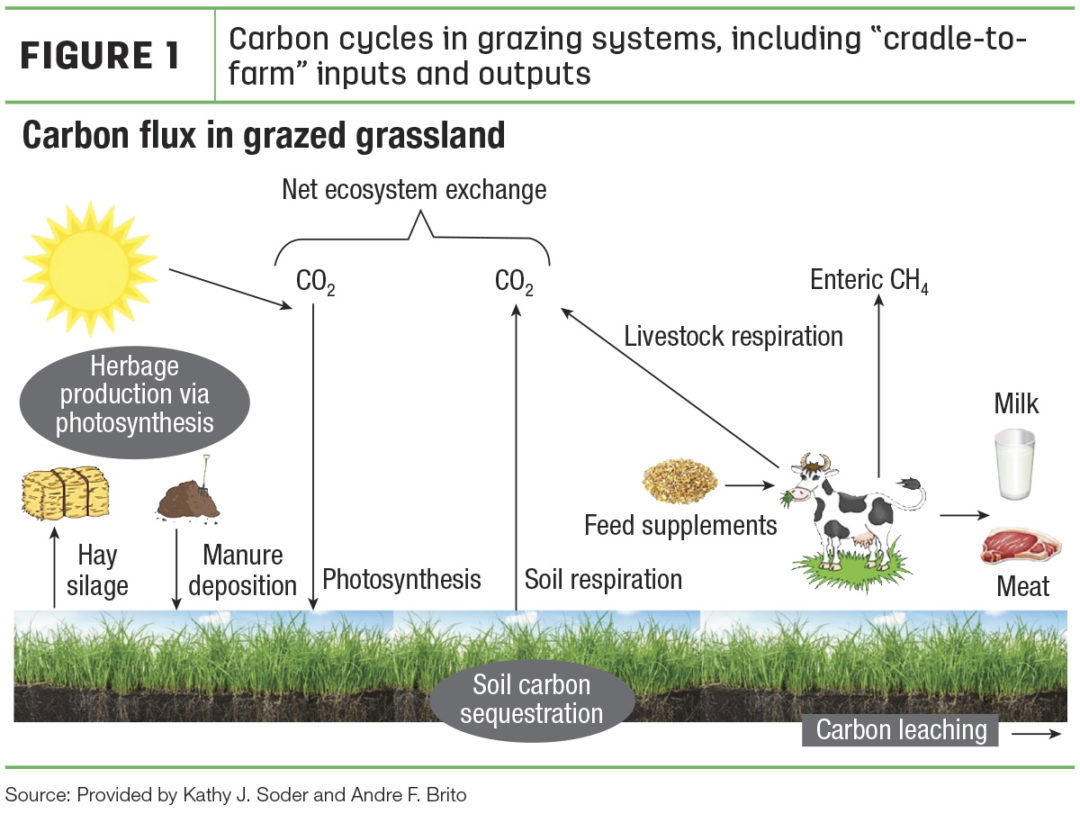Grazing systems have been targeted as a source of greenhouse gas emissions due to high-forage diets and decreased forage quality. Reducing methane emissions from grazing dairy systems worldwide is challenged by the development and application of mitigation strategies that are economically viable and practical to be adopted in grazing management systems, particularly with specialty markets such as grass-fed or certified organic.
Impact of forage quality
While many factors can affect methane emissions in dairy cows, diet quality plays a primary role. Forage-based diets often result in greater methane emissions than diets that contain increased amounts of highly fermentable sugars such as grains, in part due to shifts in volatile fatty acids (VFAs) toward propionate production, which is a byproduct of microbial fermentation in the rumen. High-forage diets favor production of other VFAs such as acetate and butyrate that release free hydrogen ions, whereas propionate removes hydrogen. Note that hydrogen and carbon dioxide are used by ruminal microbes to make methane. Consequently, diets that increase propionate and decrease acetate are often associated with a reduction in ruminal methane production.
Type and maturity of forage have been shown to affect methane emissions. For example, methane emissions were lower when ruminants were fed legumes compared to grasses, which may be a result of more rapid fermentation of plant cell walls in legumes such as birdsfoot trefoil that contain higher levels of tannins.
Forages at advanced stages of maturity result in reduced sugar concentration and greater lignification of plant cell walls, thereby elevating acetate production in the rumen, thus increasing methane produced per unit of forage digested. However, reduced forage quality can also decrease dry matter intake (DMI) which is correlated with methane production. Therefore, decreases in methane production may simply be a matter of decreased intake and not forage quality.
Pasture management
Research on how pasture management affects methane emissions in grazing dairy cows is limited, but a study from Chile reported that while grazing management which favored higher-quality pasture had no effect on total methane output (in grams per day), methane intensity (grams of methane per unit of milk produced) was moderately reduced due to increased milk production by grazing dairy cows due to a dilution effect of methane over greater productivity. However, improving forage quality through pasture management is not a surefire way to reduce methane output in grazing dairy cows due to dependency on weather and other environmental factors, and more research is needed.
Supplements
Energy
Energy is the most limiting nutrient for pasture-based dairy cows. Some research has shown that supplementing grazing dairy cows can not only improve milk yield but can also decrease methane output. However, other studies show no beneficial effects on methane output. Results may be affected by differences in the type and proportion of grazed pasture, type and amount of grain, stage of lactation, milk production level and grazing management.
Lipids
Lipids such as oilseeds are also used as an energy source – but can be costly, difficult to be implemented for grazing ruminants and can negatively impact fiber digestibility. However, lipids can decrease methane output by up to 60% in studies done with beef and dairy cattle due to the toxic effect of the fat on microbes. Research conducted with grazing dairy cows supplemented with crushed rapeseed (10% of the diet dry matter) or sunflower oil (0.85 pound of oil per cow per day) consistently decreased methane output, but no change was observed in grazing cows offered 10% (diet dry matter) of ground flaxseed. Differences in the diet, grazed herbage species, and type and amount of lipids supplemented are likely responsible for inconsistent responses in methane output across studies.
Nitrates
Nitrate supplementation has been extensively evaluated to reduce methane production in confined dairy cows, but there is limited research under grazing conditions. However, studies conducted with grazing dairy cows supplemented with varying levels of nitrate showed little effect on methane production, which could possibly be due to high nitrate concentrations in grazed forage.
Seaweed
There is a growing interest feeding seaweed to reduce methane output due to the presence of compounds such as bromoforms or phlorotannins. However, there is limited information with grazing cows, and data that does exist often shows negative effects on nutrient digestibility or milk production. In addition, seaweed can be cost-prohibitive, and the shelf life of the product is limited due to degradation of the compounds that affect methane production. Finally, there are concerns that seaweeds may cause increased bromoforms and iodine to milk, which can potentially jeopardize human health.
Condensed tannins
Condensed tannins are compounds naturally produced by some forages and grains as a defensive mechanism against predation by ruminants and insects. Condensed tannins are classified as low to medium methane reducers with most research to date done in vitro (such as with simulated rumens in the lab) and require further studies done with cows.
'Cradle-to-farm' assessments
While high-forage diets can be a significant source of methane production from cows, grazing-based systems make use of perennial crops and permanent pastures which provide a variety of ecosystem services that may offset methane output. Such services include carbon sequestration, improved soil health, reduced soil erosion and weed invasion, provision of wildlife habitat and improved biodiversity.
Unlike cropping systems where much of the plant carbon is exported as forage or grain, perennial pastures retain a greater fraction of plant biomass in the soil, thereby sustaining greater amounts of soil organic matter (and carbon). Furthermore, grazing animals return much of the carbon in harvested forage in the form of manure depositions on pasture, thus reducing net carbon removal from the system (Figure 1).

It must be recognized that well-managed perennial pastures are not an infinite carbon sink. Pastures that have been established for decades may have reached a saturation point for soil carbon and no longer sequester additional carbon. On the other hand, these pastures still serve as net sinks of soil carbon by withholding carbon from the atmosphere. However, a handful of regional long-term studies recently challenged the notion of carbon saturation of soils by showing that carbon sequestration may continue, particularly when management is improved, such as converting annual crops to perennial pastures or improving grazing management.
Dietary changes designed to reduce greenhouse gas production often increase production costs. For these changes to be adopted commercially, there must also be a positive economic impact such as increased milk production or more efficient growth. Evaluating net greenhouse emissions from any farming enterprise requires a “cradle-to-farm” assessment (see Figure 1) that seeks to describe the entire farm system, not just one component. However, such studies are limited. For example, while feeding increased levels of grain in the dairy diet may not change daily methane production, methane will be diluted over a higher milk yield when expressed as grams of methane per unit of milk, thereby appearing as though the environmental impact is lower.
However, there are other inputs that must be considered. For example, cereal forages used to produce grains as animal feed typically require fertilizer, harvesting and preservation, which contribute to greenhouse emissions through the burning of fossil fuels. Feeding grain can also increase methane emissions from manure because the volatile solids content of manure increases with increased digestible energy content of the diet. Grazing systems reduce or avoid many of these inputs, thereby decreasing greenhouse emissions, which illustrates the importance of using a “cradle-to-farm” assessment to evaluate the contribution of grazing dairy systems on net greenhouse emissions. The challenge to scientists, and ultimately producers, is how to leverage these plant-animal-soil relationships to improve sustainable intensification of pasture-based dairy systems.






